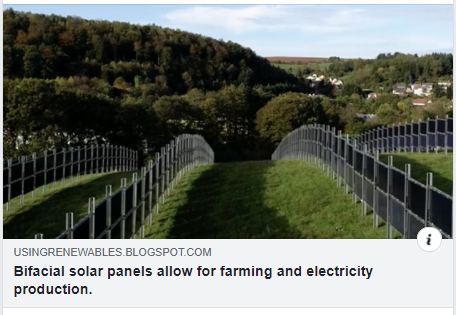“Bifacial” Solar Panels

Agrophotovoltaic projects are appearing around the world where solar panels and farming go hand in hand. A more common one is where sheep graze within a solar farm to be living grass clippers that are provided with much needed shade. However in Germany, Next2Sun has developed bifacial solar panels with one side facing east and the other west.
Agrophotovoltaics is a fancy word that means it is possible to combine solar power with farming in a way that benefits both. In theory, it would be possible to meet all the world’s electrical needs with solar panels but they can’t be mounted on the permafrost in Siberia, which is rapidly melting, or high atop the world’s mountains. Nor can they float out in the middle of the ocean. For maximum efficiency, they should be located as near as possible to the places where the electricity they generate will be used or near existing transmission lines. They also should be sited away from forests and structures that will cast shadows on them during the day.
I’m afraid you’re the victim of a hoax. Think about this for a moment.
Solar panels are aimed to the south (in the Northern Hemisphere) since that’s the direction from which the sun gives us the most energy. That’s why it’s hotter in the middle of the day than it is at dawn and dusk.
They are tilted at an angle that depends on the latitude so as to maximize the incident energy.
This is why “bifacial” solar panels do not exist; the sun doesn’t shine on the exposed side.
In addition:
The reason there are no solar panels in Siberia isn’t that the permafrost is melting, rather that the solar irradiance is very low and virtually no one lives there.
Can you imagine the increased cost to the farmer of maintaining those fields? Outside of grazing sheep, there is no other conceivable use of the land. Cows knock stuff down. Crops need to be planted, fertilized, irrigated and harvested.
Hoaxerama.

Bifacial solar panels do exist, and with very little extra cost get a boost from light reflected off the ground. The boost can vary from a few percent over dark ground, or where the panels are close to the ground to around 30% over highly reflective ground. I even heard of one instalation at a research station in Antarctica which was deliberately mounted upside down to stay clear of snow and capture reflected light. Re solar panels in Siberia, I bet there are some as although the sunshine is not great, the cost of generating electricity by other means is likely also high due to remoteness. (The same applies in Alaska for the same reason)
Thanks. Interesting. What about orienting them north/south? In farmers’ fields?